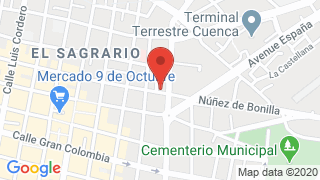Azuay



Azuay, Architectural Cradle of Ecuador
In the inter-Andean region in southern Ecuador, the province of Azuay is one of the 24 provinces of Ecuador.
The capital of the province is Cuenca
Azuay celebrates its provincialization on June 25, 1824.
Azuay Weather
The climate is variable, with the presence of the mountainous system and also a subtropical vegetation. In the Andean zone the average temperature is of about 19 ° C and of 26 ° C in the tropical zone.
Area: 7,701 km2.
Population: 506,090
There are 15 cantons that make up the province of Azuay, starting with the canton Cuenca, Girón, Gualaceo, Chordeleg, Sigsig, San Fernando, Santa Isabel, Camilo Ponce Enríquez, El Pan, Girón, Guachapala, Gualaceo, Nabón, Oña, Pucará.
Limits of the province of Azuay
- North: Cañar Province
- South: Loja Province
- East: Provinces of Zamora Chinchipe and Morona Santiago
- West: Provenance of Guayas and El Oro
Tourist places of Azuay
- El Chorro Waterfall: It is a majestic double waterfall, within an attractive mountain landscape.
- The Filigree: Making jewelry was a usual job in Chordeleg, more than 70 percent of its inhabitants are engaged in this work, you could say that all its inhabitants are.
- Lord of the Miracles of Andacocha: For many decades the Guachapala canton has been characterized by religious tourism that is developed especially in the Andacocha sector.
- Nariguiña Lagoon: The lagoon on the other hand presents a more or less circular form, of crystalline waters surrounded by beautiful mountains of the most pronounced cliffs.
- New Immaculate Conception Cathedral: It is a Catholic temple, the most representative religious symbol and the largest architectural monument in Cuenca. It has a Renaissance Gothic style.
- Lagartococha Lagoon: On its banks it is possible to camp and the place is very popular for sport fishing. Next to Lagartococha is the "Cave of the Dead", named because travelers from more than a century ago would have died on the site, victims of malaria.
- Avilahuayco: It acts as a natural viewpoint for watchtowers; the panorama it offers from its summit is very attractive since you can see "the boxes" that dominate the whole area from there.
- Loma de Tres Cruces: It is one of the highest parts of the Park where the watershed is located between those that go to the Amazon and those that move towards the Pacific. García Moreno Road crosses there and tradition tells that it owes its name to the many dead people who tried to spend the night on their trip from the coast, but who, because of the intense cold of the night, failed to see the sunrise.
- Laguna Taitachungo (Mamamag): Starting from the Toreadora there are some paths that lead to it. From here you can follow a stretch of the Ingañán or Road of the Inca towards the cave of Luspa. In Mamamag other remains of pre-Inca constructions have been found represented by stone stands and foundations of some type of building, presumably rooms to spend the night; more than houses, these buildings seem to have served as drums, travel shelters, since the site is key to the passage to the coast.
Gastronomy of the province of Azuay
In this wonderful province, smells, flavors and seasonings that characterize the cuisine of Cuenca predominate, and which is a clear example of miscegenation.
Typical foods identify each culture in the world because they are typical of the place, there is a wide variety of cuisine that many do not know, so it is very important to know the delicacies that the Austro has, a great gastronomic syncretism.
A clear example of the delights that the austro has, is the dish called dead pig where you can taste its cascarita, fried, blood sausage and this is accompanied by mote, toast and llapingachos. Another delight of Azuay, and is one of the favorite dishes of foreigners and Ecuadorians who come to try from all provinces. This dish that consists of baked pork, mote, llapingachos and onions.
A dish that cannot be missed in the gastronomy of Cuenca is the mote pillo that mainly contains the mote, lard, eggs and we can aromatize with some herbs, this dish is also accompanied with roast pork or beef.
Among other culinary delights typical of the austro's gastronomy are: the broth of legs, corn and corn tortillas, guinea pig with potatoes, tortillas (empanadas) with morocho (local variety of corn), chicken soup, champú, the morocho, llapingachos, dirty maize and trout from the Cajas area.
Culture and traditions of Azuay
Popular festivities:
- Peach Festival - Gualaceo - Aarzo
- Guinea Pig Festival - Ricaurte - February
- Cane Festival - Santa Isabel - September
- Bullfight Festival - Girón - October and November
- El Niño Pass - Cuenca - December
Azuay history
The first registered settlements date back 10 thousand years in Chobshi and Cubilán. It had different migratory periods from the mountains like the Cañaris. Later it was conquered by the Incas under the command of Túpac Yupanqui. The Spanish colonization occurred when Francisco Pizarro, commissioned Captain Rodrigo Núñez de Bonilla to exercise the functions of encomendero in the distribution of the Province of Los Cañaris or Tomebamba in 1538; during that period the maximum and precursor entity of the province would be the Corregimiento de Cuenca, after the independence war and the annexation of Ecuador to Gran Colombia, the Province of Cuenca is created on June 25, 1824 (which in 1835, would change its name to Azuay), which makes it one of the first 7 provinces of Ecuador. This province is the corollary of the subdivision of the former Department of Azuay.

Publicado en:
Publicado por:



